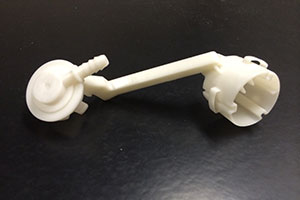
One common question that we hear when designing and building injection molds is “What is the cooling time required within the injection mold?” The answer to the required cooling time depends upon several factors including the processing parameters, the material used, and of course the part and mold design itself.
Molding Parameters Affecting Cooling Time and Shrink Rate
Molding parameters have a significant impact upon the final properties of an injection molded part. Processing conditions affecting the final part geometry include temperatures, packing parameters (clamping pressure and barrel size), cooling time, and injection speed. Each of these conditions plays a role in how the material will solidify and how much cooling time is required to meet part specifications.
The injection molding processor should work closely with the mold designer for optimum tool design based on the molding conditions.
Resin and Shrink Rate
While the resin will have direct impact on cooling and shrink rate as each polymer has specific properties, the molding conditions also have significant impact on the final material properties for any part design. The two most important molding parameters affecting the polymer material are the melt temperature, and the mold temperature.
Skilled mold designers are well versed in the various properties of polymer resins, and will design the mold with specific molding process parameters in mind, in addition to the shrink rate of the material.
Mold Design and Cooling Time
The mold design, or rather the geometry of the part itself, will impact how the part cools in the mold. When the part begins to cool, it begins solidifying closest to the mold moving inwards towards the center. Therefore, parts that are thick can have the center area not solidify fast enough which causes stress resulting in sink marks on the outer surface.
If the part contains areas of uneven wall thickness, stresses may develop during the cooling stage when thinner sections solidify quicker than thicker sections causing a warp in the part.
A skilled design engineer will know how the part will cool in the mold based on the part geometry, resin used, and processing parameters, and will design the cooling system accordingly. The cooling system consists of water lines running through the mold to cool the part properly. Mold designers must be careful so that cooling lines do not interfere with the clamping system or tie-bar of the molding press.
Michiana Global Mold is a custom, precision mold making company, with vast experience designing complex tools used in a variety of molding conditions. We combine our experience with the latest in technological advancements to provide a computer aided mold design that will best suit your project requirements based on manufacturing conditions, resin used and part geometry.

